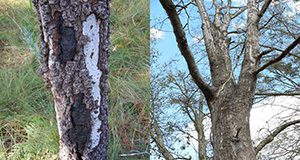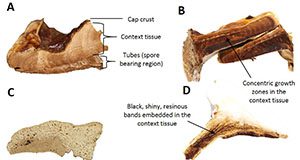Biscogniauxia canker or dieback is a common contributor to poor health and decay in a wide range of tree species growing in many different habitats, such as forests, parks, green spaces, and urban areas, in Florida. This disease is caused by several species of fungi in the genus Biscogniauxia (formerly Hypoxylon). These pathogens do not typically harm healthy and vigorous trees, but once they infect trees under stress from drought, root disease, soil compaction, construction damage or other causes, they can quickly colonize the tree. Once a tree is infected and fruiting structures of the fungus are evident, the tree is not likely to survive, especially if the infection is in the trunk. This 3-page fact sheet written by Claudia Paez and Jason Smith and published by the UF/IFAS School of Forest Resources and Conservation explains the pathogen’s biology and lists signs and symptoms as well as control measures and ways to keep trees healthy to resist infection.
http://edis.ifas.ufl.edu/fr407
Tag: Jason Smith
The Laccate Ganoderma of the Southeastern United States: A Cosmopolitan and Important Genus of Wood Decay Fungi
Ganoderma Karst. is a large and diverse genus of wood decay fungi that can rot the roots and/or lower trunk of many tree species. There are several laccate (varnished or polished) Ganoderma species that are found in the southeastern United States and this six-page fact sheet provides an overview of the different species. Written by Andrew L. Loyd, Jason A. Smith, Brantlee S. Richter, Robert A. Blanchette, and Matthew E. Smith and published by the Plant Pathology Department.
http://edis.ifas.ufl.edu/pp333
FOR269/FR331 Annosum Root Rot of Southern Pines
FOR269, a 3-page illustrated fact sheet by Tyler Dreaden and Jason Smith, describes this damaging forest pathogen that infects a wide range of species, including southern pine, and can cause tree mortality, reduced growth rates, susceptibility to attack by bark beetles, and regeneration failure. Includes references. Published by the UF School of Forest Resources and Conservation, July 2010.
http://edis.ifas.ufl.edu/fr331
FOR238/FR300 Red Root and Butt Rot of Sand Pine
FOR238, a 3-page illustrated fact sheet by Marc Hughes and Jason Smith, describes this important root disease of mature and over-mature sand pines — causal agent, symptoms and signs, disease cycle, and management. Includes references. Published by the UF School of Forest Resources and Conservation, May 2010.
http://edis.ifas.ufl.edu/fr300

